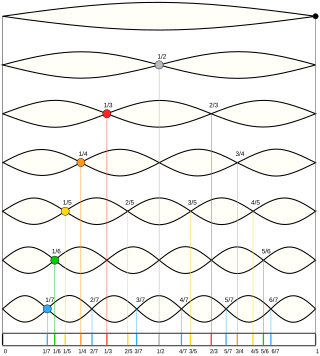
Acoustics is a branch of physics that deals with the study of mechanical waves in gases, liquids, and solids including topics such as vibration, sound, ultrasound and infrasound. A scientist who works in the field of acoustics is an acoustician while someone working in the field of acoustics technology may be called an acoustical engineer. The application of acoustics is present in almost all aspects of modern society with the most obvious being the audio and noise control industries.

A harmonic series is the sequence of harmonics, musical tones, or pure tones whose frequency is an integer multiple of a fundamental frequency.

In physics, acoustics, and telecommunications, a harmonic is a sinusoidal wave with a frequency that is a positive integer multiple of the fundamental frequency of a periodic signal. The fundamental frequency is also called the 1st harmonic; the other harmonics are known as higher harmonics. As all harmonics are periodic at the fundamental frequency, the sum of harmonics is also periodic at that frequency. The set of harmonics forms a harmonic series.

Pitch is a perceptual property of sounds that allows their ordering on a frequency-related scale, or more commonly, pitch is the quality that makes it possible to judge sounds as "higher" and "lower" in the sense associated with musical melodies. Pitch is a major auditory attribute of musical tones, along with duration, loudness, and timbre.

The speed of sound is the distance travelled per unit of time by a sound wave as it propagates through an elastic medium. At 20 °C (68 °F), the speed of sound in air is about 343 m/s, or one km in 2.91 s or one mile in 4.69 s. It depends strongly on temperature as well as the medium through which a sound wave is propagating. At 0 °C (32 °F), the speed of sound in air is about 331 m/s. More simply, the speed of sound is how fast vibrations travel.

An Aeolian harp is a musical instrument that is played by the wind. Named after Aeolus, the ancient Greek god of the wind, the traditional Aeolian harp is essentially a wooden box including a sounding board, with strings stretched lengthwise across two bridges. It is often placed in a slightly opened window where the wind can blow across the strings to produce sounds. The strings can be made of different materials and all be tuned to the same pitch, or identical strings can be tuned to different pitches. Besides being the only string instrument played solely by the wind, the Aeolian harp is also the only string instrument that plays solely harmonic frequencies. They are recognizable by the sound which is a result of this property, which has been described as eerie and ethereal.

A combination tone is a psychoacoustic phenomenon of an additional tone or tones that are artificially perceived when two real tones are sounded at the same time. Their discovery is credited to the violinist Giuseppe Tartini and so they are also called Tartini tones.

In fluid dynamics, vortex shedding is an oscillating flow that takes place when a fluid such as air or water flows past a bluff body at certain velocities, depending on the size and shape of the body. In this flow, vortices are created at the back of the body and detach periodically from either side of the body forming a Kármán vortex street. The fluid flow past the object creates alternating low-pressure vortices on the downstream side of the object. The object will tend to move toward the low-pressure zone.

An organ pipe is a sound-producing element of the pipe organ that resonates at a specific pitch when pressurized air is driven through it. Each pipe is tuned to a note of the musical scale. A set of organ pipes of similar timbre comprising the complete scale is known as a rank; one or more ranks constitutes a stop.

Helmholtz resonance, also known as wind throb, refers to the phenomenon of air resonance in a cavity, an effect named after the German physicist Hermann von Helmholtz. This type of resonance occurs when air is forced in and out of a cavity, causing the air inside to vibrate at a specific natural frequency. The principle is widely observable in everyday life, notably when blowing across the top of a bottle, resulting in a resonant tone.

Acoustic resonance is a phenomenon in which an acoustic system amplifies sound waves whose frequency matches one of its own natural frequencies of vibration.

In music, the bore of a wind instrument is its interior chamber. This defines a flow path through which air travels, which is set into vibration to produce sounds. The shape of the bore has a strong influence on the instrument's timbre.

Violin acoustics is an area of study within musical acoustics concerned with how the sound of a violin is created as the result of interactions between its many parts. These acoustic qualities are similar to those of other members of the violin family, such as the viola.

Underwater acoustics is the study of the propagation of sound in water and the interaction of the mechanical waves that constitute sound with the water, its contents and its boundaries. The water may be in the ocean, a lake, a river or a tank. Typical frequencies associated with underwater acoustics are between 10 Hz and 1 MHz. The propagation of sound in the ocean at frequencies lower than 10 Hz is usually not possible without penetrating deep into the seabed, whereas frequencies above 1 MHz are rarely used because they are absorbed very quickly.

In physics, sound is a vibration that propagates as an acoustic wave through a transmission medium such as a gas, liquid or solid. In human physiology and psychology, sound is the reception of such waves and their perception by the brain. Only acoustic waves that have frequencies lying between about 20 Hz and 20 kHz, the audio frequency range, elicit an auditory percept in humans. In air at atmospheric pressure, these represent sound waves with wavelengths of 17 meters (56 ft) to 1.7 centimeters (0.67 in). Sound waves above 20 kHz are known as ultrasound and are not audible to humans. Sound waves below 20 Hz are known as infrasound. Different animal species have varying hearing ranges.

A wind instrument is a musical instrument that contains some type of resonator in which a column of air is set into vibration by the player blowing into a mouthpiece set at or near the end of the resonator. The pitch of the vibration is determined by the length of the tube and by manual modifications of the effective length of the vibrating column of air. In the case of some wind instruments, sound is produced by blowing through a reed; others require buzzing into a metal mouthpiece, while yet others require the player to blow into a hole at an edge, which splits the air column and creates the sound.
The whirly tube, corrugaphone, or bloogle resonator, also sold as Free-Ka in the 1960s-1970s, is an experimental musical instrument which consists of a corrugated (ribbed) plastic tube or hose, open at both ends and possibly wider at one end (bell), the thinner of which is rotated in a circle to play. It may be a few feet long and about a few inches wide. The faster the toy is swung, the higher the pitch of the note it produces, and it produces discrete notes roughly belonging to the harmonic series, like a valveless brass instrument generates different modes of vibration. However, the first and the second modes, corresponding to the fundamental and the second harmonics, are reported as being difficult to excite. To be played in concert the length of the tube must be trimmed to tune it.

Equalization, or simply EQ, in sound recording and reproduction is the process of adjusting the volume of different frequency bands within an audio signal. The circuit or equipment used to achieve this is called an equalizer.
A whistle is a device that makes sound from air blown from one end forced through a small opening at the opposite end. They are shaped in a way that allows air to oscillate inside of a chamber in an unstable way. The physical theory of the sound-making process is an example of the application of fluid dynamics or hydrodynamics and aerodynamics. The principles relevant to whistle operation also have applications in other areas, such as fluid flow measurement.

The Aeolus Acoustic Wind Pavilion is a musical installation artwork created by Luke Jerram. It is a large aeolian harp that was inspired by Jerram's time in Iran. The installation toured England from 2011 to 2012, appearing at Lyme Park, the Eden Project, MediaCityUK and Canary Wharf.





















